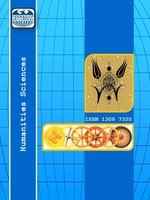SANAT VE TASARIM E?YTYMYNYN RENKLERYN ANLAMLANDIRILMASI ÜZERYNDEKY ETKYSY
Güçlü bir anlatym aracy olan renkler, insanlyk tarihinde yalnyzca sanat alanynda de?il, genelde tüm kültürel, sosyal, hatta siyasal ya?amda etkili bir görsel ö?e olmu?tur. Renk, insanlyk tarihinin her döneminde de?i?ik biçimlerde kullanylmy? ve önemini de korumu?tur. Rengin, kendi içinde bir anlatym ve etkileme özelli?i olmasyndan kaynaklanan bir ileti?im özelli?i vardyr. Renk, hem estetik bir ö?e, hem de bir ifade aracy olarak görsel sanatlaryn tümünde sanatçynyn yararlandy?y önemli bir anlatym ö?esi olmu?tur. Bu makalenin amacy rengin algylanmasy ve anlamlandyrylmasyyla sanat ve tasarym e?itimi alma arasyndaki ili?kiyi ortaya çykarmaktyr. Ara?tyrma, sanat ve tasarym e?itimi almy?, renk konusunda teorik bilgi düzeyi yüksek ki?ilerin özellikle ara renkleri anlamlandyrmada renk konusunda e?itim almamy? ki?ilere oranla çok daha do?ru algylamaya sahip oldu?u bulgusuna ula?my?tyr. Ana renklerin anlamlandyrylmasynda önemli bir fark bulunamamy?tyr. Çaly?manyn evrenini Selçuk Üniversitesi'nde ö?renim gören 460 ö?renci olu?turmu?tur.
Anahtar Kelimeler:
Renk, Sanat e?itimi, Görsel sanatlar, Grafik tasarym, Renklerin anlamlary,
THE INFLUENCE OF ART AND DESIGN EDUCATION ON THE INTERPRETATION OF COLOR
As a powerful means of expression, colors have been an influential visual factor throughout human history not only in the field of arts, but also in general aspects of cultural, social and even political life. Color is being used in various modes and retained it's significance throughout all human ages. Colors possess a communicative quality which arises from their inherent ability for expression and affection. As fundamental component of visual arts, color has been used by artists as both an aesthetical and expressional means. The aim of this study is to explore the relationship between the perception-interpretation of colors and the state of education in arts and design. The study has found that individuals with a higher level of theoretical knowledge on colors have a much more accurate perception of particularly the secondary colors than individuals without this level of education. Significant difference in the interpretation of the primary colors has not been found. The sample of the study consisted of 460 students of the Selcuk University.
Keywords:
Color, Arts education, Visual arts, Graphics design, Meanings of colors, ,
- Başlangıç: 2009
- Yayıncı: E-Journal of New World Sciences Academy
Sayıdaki Diğer Makaleler
TARİHİ SÜREÇ İÇERİSİNDE TOPLUM-ÇEVRE İLİŞKİLERİ VE ÇEVRE SORUNLARININ ORTAYA ÇIKIŞI
SANAT VE TASARIM E?YTYMYNYN RENKLERYN ANLAMLANDIRILMASI ÜZERYNDEKY ETKYSY
DIE GESCHICHTE VOM BRAVEN KASPERL UND DEM SCHÖNEN ANNERL - EINE ERZÄHLUNG VON CLEMENS BRENTANO -
A? TOPLUMUNDA SOSYALLE?ME VE PAYLA?IM: FACEBOOK ÜZERYNE AMPYRYK BYR ARA?TIRMA
Göksel GÖKER, Mustafa DEMİR, Adem DOĞAN
KURUM KÜLTÜRÜNÜN OLU?UMUNDA KURUM YÇY MOTYVASYONUN ROLÜ ÜZERYNE TEORYK BYR ÇALI?MA
YNGYLYZCENYN YABANCI DYL OLARAK KULLANIMINDA TOPLUMEDYM HATALARI
